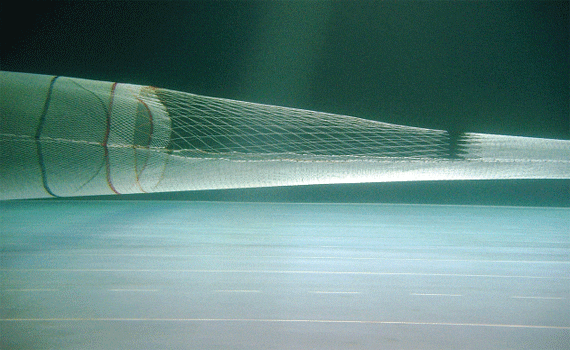
Belly of the trawl
This has been trialled in the South West beam trawl fishery as part of CEFAS 50% project.
This type of release panel is more suited to fisheries where a lot of benthic debris and invertebrates are entering the mouth of the trawl. Much of these will be ‘riddled’ out through the square mesh panel in the lower sheet of the trawl.
Many of the small sole, megrims and monks will also escape through this type of panel. The square mesh panel in this position is not very effective for releasing the round fish from the trawl, as they tend to swim higher above the lower panel clear of the sand cloud.
In a Nephrops trawl many of the smaller Nephrops would probably be lost through the square mesh as they trundle along the lower panel of netting.
Cod ends and extensions
Several skippers have been experimenting with this type of codend, and it was trialled as part of the CEFAS 50% project on some beam trawlers in the South West.
In many flatfish fisheries skippers are adopting square mesh codends to prevent capture of the many small round fish, yet retain almost all the flatfish above the Minimum Landing Size (MLS).
For the release of small undersized round fish inserting square mesh on top, and/or lower panels in the codend and/or extension, is one of the most effective escape devices available.
With the square open meshes being at the aft end of the trawl, where there is a much reduced water flow, the small fish have time to recover from the trauma of being captured and swept down the trawl.
By being exposed to the square mesh for the duration of the tow they have adequate time to find their escape path through the open meshes, unlike a square mesh panel where they have only a few seconds to make their escape.
The size of square mesh used needs to be balanced to the size of round fish that the vessel wants to retain.
The square shape of the meshes is better suited to the cross sectional shape of round fish, rather than flat fish, allowing them to escape more readily.
Many skippers have reported that they have seen no difference in the retained catch of flat fish when they have fitted a square mesh codend of a similar mesh size to their original diamond mesh, but have managed to release in the region of 90% of the small round fish.
To further improve the selectivity of a square mesh codend it can be made using four panels (if regulation allows this in the particular fishery), instead of the normal two, as this helps the extension stay more open, allowing the fish more space to swim in before escape.
Trials with square mesh codends in Nephrops fisheries have resulted in the loss of many of the smaller Nephrops through the open meshes.
With some work it may be possible to get a configuration of square and diamond mesh in a Nephrops trawl that will release most of the small round fish, but retain enough of the larger Nephrops for the vessel to maintain its profitability.
There have been a few legislative issues with the use of square mesh codends and extensions so it is always better to check with the local fishery officer before using one.
When codends and extensions of square mesh (T45) and T90 mesh are used they are much more stable than a diamond mesh codend, as they are being towed.
This is due to the much improved water flow through the codend which results in improved catch quality, and increased opportunity for small fish to escape.
April 2012
Further Reading
| |
- | Go to our previous news item on this story by clicking here. |

